Exploitation and Maintenance of Biomethane-Powered Truck and Bus Fleets to Assure Safety and Mitigation of Greenhouse Gas Emissions
Abstract
:1. Introduction
2. Literature Review
- It is non-toxic, non-carcinogenic, not hazardous to water, slightly soluble in water, colorless, and odorless, with no increased hazard potential compared to diesel.
- The density of natural gas, or methane, is 0.68 kg/m3 @ 15 °C, so it is lighter than propane (1.87 kg/m3) and butane (2.44 kg/m3). From the aspect of safety and fire protection, it is necessary to know that in case of damage to equipment or cylinders, biomethane flows upwards because it is lighter than air.
- The auto-ignition temperature range of natural gas (480–650 °C) is much higher compared to that of other fuels: methane (595 °C), propane (495 °C), butane (480 °C), gasoline (range of 260–430 °C), and diesel (less than 260 °C).
- It is flammable as gas in concentrations (5–15%) in combination with air, for propane (2.4–9.3%), butane (1.8–8.8%), gasoline (1.4–7.6%), and diesel (0.6–7.5%).
- Only biomethane drive (dedicated);
- A propulsion system on two independent fuels (bi-fuel);
- A propulsion system mainly for truck engines, where diesel fuel is used for the initial ignition of biomethane (dual-fuel).
3. Data and Methods for Emission Quantification
- —wheel-to-wheel (WtW) energy consumption [MJ∙(100 km)−1];
- —tank-to-wheel (TtW) energy consumption [MJ∙(100 km)−1];
- —fuel consumption [L∙(100 km)−1];
- —the WtW energy factor regarding consumed fuel [MJ∙(L)−1];
- —TtW energy factor regarding consumed fuel [MJ∙(L)−1].
- —WtW emissions of CO2 [gCO2e];
- —TtW emissions of CO2 [gCO2e];
- —the WtW emission factor regarding consumed fuel [gCO2e∙MWh−1];
- —the TtW emission factor regarding consumed fuel [gCO2e∙MWh−1].
4. The Results of Calculating the Bus Structure
- E3—biomethane equipment is approved in Italy;
- R-042439—the approval number according to the homologation UN ECE 110R;
- L—the product is compatible with LNG;
- M—the product is intended for use in working conditions at moderate temperatures;
- C—the product is intended for use in working conditions at cold temperatures.
- FoS = 3.60—for U profiles;
- FoS = 1.68—in the bolts (M12) for the connection of CNG cylinders with U profiles regarding pressure and elongation;
- FoS = 1.53—for the completed supporting roof structure.

- Problems with the biomethane injection system: This can include gas leaks, blocked injectors, or any problems with the gas injection system itself.
- Problems with the gas cylinders: This is where gas leaks, damage to the cylinder, or any other problems related to the gas cylinder itself can occur.
- Problems with the pressure regulator: The pressure regulator is a key part of the biomethane fuel system, and problems with it can cause the entire system to malfunction.
- Problems with electrical installation: Sometimes, problems can be electrical in nature, such as problems with sensors, connections, or electrical installations related to the biomethane fuel system.
- Damage to the protective ventilation cover, which also includes damage to and clogging of the ventilation pipes;
- Damage and clogging of the ventilation pipe of the automatic valve on the cylinder neck;
- Inadequate fastening and protection of pipes, cylinders, and other parts in the fuel supply system;
- Leaking gas.
5. Discussion
6. Conclusions
Author Contributions
Funding
Data Availability Statement
Conflicts of Interest
References
- Marotta, A.; Pavlovic, J.; Ciuffo, B.; Serra, S.; Fontaras, G. Gaseous Emissions from Light-Duty Vehicles: Moving from NEDC to the New WLTP Test Procedure. Environ. Sci. Technol. 2015, 49, 8315–8322. [Google Scholar] [CrossRef]
- Milojević, S.; Glišović, J.; Savić, S.; Bošković, G.; Bukvić, M.; Stojanović, B. Particulate Matter Emission and Air Pollution Reduction by Applying Variable Systems in Tribologically Optimized Diesel Engines for Vehicles in Road Traffic. Atmosphere 2024, 15, 184. [Google Scholar] [CrossRef]
- Reitz, R.D.; Ogawa, H.; Payri, R.; Fansler, T.; Kokjohn, S.; Moriyoshi, Y.; Agarwal, A.K.; Arcoumanis, D.; Assanis, D.; Bae, C.; et al. IJER Editorial: The Future of the Internal Combustion Engine. Int. J. Engine Res. 2020, 21, 3–10. [Google Scholar] [CrossRef]
- Pramanik, S.; Anwar, S. Predictive Optimal Control of Mild Hybrid Trucks. Vehicles 2022, 4, 1344–1364. [Google Scholar] [CrossRef]
- Milojevic, S.; Skrucany, T.; Miloševic, H.; Stanojevic, D.; Pantic, M.; Stojanovic, B. Alternative drive systems and environmentally friendly public passengers transport. Appl. Eng. Lett. 2018, 3, 105–113. [Google Scholar] [CrossRef]
- Obrecht, M.; Yangınlar, G.; Tatar, D.K.; Knez, M. Sustainable transportation perspective: How our preferences for zero-emission vehicles change through time? Prod. Eng. Arch. 2024, 30, 214–224. [Google Scholar] [CrossRef]
- Garbier, M.; Čorejová, T. Efficiency of Battery Systems from the Point of View of Economic Return. Prod. Eng. Arch. 2024, 30, 344–353. [Google Scholar] [CrossRef]
- Niyomphon, K.; Nakkiew, W. Application of Metaheuristics for Multi-Trip Capacitated Vehicle Routing Problem with Time Window. Prod. Eng. Arch. 2024, 30, 303–313. [Google Scholar] [CrossRef]
- Milojević, S. Sustainable application of natural gas as engine fuel in city buses: Benefit and restrictions. J. Appl. Engin. Sci. 2017, 15, 81–88. [Google Scholar] [CrossRef]
- Settey, T.; Gnap, J.; Synák, F.; Skrúcaný, T.; Dočkalik, M. Research into the Impacts of Driving Cycles and Load Weight on the Operation of a Light Commercial Electric Vehicle. Sustainability 2021, 13, 13872. [Google Scholar] [CrossRef]
- Abubakar, I.R.; Maniruzzaman, K.M.; Dano, U.L.; AlShihri, F.S.; AlShammari, M.S.; Ahmed, S.M.S.; Al-Gehlani, W.A.G.; Alrawaf, T.I. Environmental Sustainability Impacts of Solid Waste Management Practices in the Global South. Int. J. Environ. Res. Public Health 2022, 19, 12717. [Google Scholar] [CrossRef]
- Bošković, G.; Cvetanović, A.M.; Jovičić, N.; Jovanović, A.; Jovičić, M.; Milojević, S. Digital Technologies for Advancing Future Municipal Solid Waste Collection Services. In Digital Transformation and Sustainable Development in Cities and Organizations; Theofanidis, F., Abidi, O., Erturk, A., Colbran, S., Coşkun, E., Eds.; IGI Global Scientific Publishing: Hershey, PA, USA, 2024; pp. 167–192. [Google Scholar] [CrossRef]
- Godoy, V.; Martín-Lara, M.A.; Garcia-Garcia, G.; Arjandas, S.; Calero, M. Environmental impact assessment of the production of biomethane from landfill biogas and its use as vehicle fuel. Renew. Energy 2024, 237, 121685. [Google Scholar] [CrossRef]
- Yousuf, A.; Melville, L. Biogas to Biomethane. Engineering, Production, Sustainability, 1st ed.; Elsevier Ltd.: London, UK, 2024; pp. 3–84. ISBN 9780443184789. [Google Scholar]
- Brkić, D.; Praks, P. Probability Analysis and Prevention of Offshore Oil and Gas Accidents: Fire as a Cause and a Consequence. Fire 2021, 4, 71. [Google Scholar] [CrossRef]
- Sun, P.; Bisschop, R.; Niu, H.; Huang, X. A Review of Battery Fires in Electric Vehicles. Fire Technol. 2020, 56, 1361–1410. [Google Scholar] [CrossRef]
- Chala, G.T.; Abd Aziz, A.R.; Hagos, F.Y. Natural Gas Engine Technologies: Challenges and Energy Sustainability Issue. Energies 2018, 11, 2934. [Google Scholar] [CrossRef]
- Hastings, N.A.J. Reliability, Availability and Maintainability. In Physical Asset Management; Springer: Cham, Switzerland, 2021. [Google Scholar] [CrossRef]
- UN ECE Regulation No. 110 Rev.3—CNG and LNG Vehicles. Available online: http://www.unece.org/trans/main/wp29/wp29regs101-120.html (accessed on 19 November 2024).
- UN ECE Regulation No. 115 Rev.1—LPG and CNG Retrofit Systems. Available online: http://www.unece.org/trans/main/wp29/wp29regs101-120.html (accessed on 19 November 2024).
- Saravanakumar, A.; Sudha, M.R.; Chen, W.H.; Pradeshwaran, V. Hydrogen and biomethane pathways to achieve sustainable transportation in circular economic concept: A review. Int. J. Hydrogen Energy, 2025; in press. [Google Scholar] [CrossRef]
- Chiaramonti, D.; Testa, L. Deploying EU biomethane potential for transports: Centralized/decentralized biogasrefinery schemes to SAF and maritime fuels. Appl. Energy 2024, 366, 123306. [Google Scholar] [CrossRef]
- Xie, D.; Kong, L.; Hu, J.; Li, H.; Wang, Y. A comparative review of biohydrogen and biomethane production from biowaste through photo-fermentation. Green Chem. 2025, 27, 1331–1347. [Google Scholar] [CrossRef]
- Bužinskienė, R. A comparative analysis of perennial grass–legume mixtures for biomethane production. Heliyon 2024, 10, e33401. [Google Scholar] [CrossRef]
- Prussi, M.; Julea, A.; Lonza, L.; Thiel, C. Biomethane as alternative fuel for the EU road sector: Analysis of existing and planned infrastructure. Energy Strategy Rev. 2021, 33, 100612. [Google Scholar] [CrossRef]
- Masilela, P.; Pradhan, A. A life cycle sustainability assessment of biomethane versus biohydrogen—For application in electricity or vehicle fuel? Case studies for African context. J. Clean. Prod. 2021, 328, 129567. [Google Scholar] [CrossRef]
- Li, K.; Acha, S.; Sunny, N.; Shah, N. Strategic transport fleet analysis of heavy goods vehicle technology for net-zero targets. Ener. Pol. 2022, 168, 112988. [Google Scholar] [CrossRef]
- Tratzi, P.; Terenzi, V.; Torre, M.; Fois, F.; Bianconi, D.; Paolini, V. Well-to-wheels emissions of garbage trucks fuelled with compressed biomethane. Trans. Res. Part D Trans. Environ. 2025, 143, 104746. [Google Scholar] [CrossRef]
- Transport Research Center. Clean Transport. Available online: https://www.cistadoprava.cz/statistiky/ (accessed on 16 January 2025).
- Lähde, T.; Giechaskiel, B. Particle Number Emissions of Gasoline, Compressed Natural Gas (CNG) and Liquefied Petroleum Gas (LPG) Fueled Vehicles at Different Ambient Temperatures. Atmosphere 2021, 12, 893. [Google Scholar] [CrossRef]
- Karczewski, M.; Szamrej, G.; Chojnowski, J. Experimental Assessment of the Impact of Replacing Diesel Fuel with CNG on the Concentration of Harmful Substances in Exhaust Gases in a Dual Fuel Diesel Engine. Energies 2022, 15, 4563. [Google Scholar] [CrossRef]
- Mahmoud, E.; Ali, L.; El Sayah, A.; Alkhatib, S.A.; Abdulsalam, H.; Juma, M.; Al-Muhtaseb, A.H. Implementing Metal-Organic Frameworks for Natural Gas Storage. Crystals 2019, 9, 406. [Google Scholar] [CrossRef]
- Noussan, M. The Use of Biomethane in Internal Combustion Engines for Public Transport Decarbonization: A Case Study. Energies 2023, 16, 7995. [Google Scholar] [CrossRef]
- Rompokos, P.; Kissoon, S.; Roumeliotis, I.; Nalianda, D.; Nikolaidis, T.; Rolt, A. Liquefied Natural Gas for Civil Aviation. Energies 2020, 13, 5925. [Google Scholar] [CrossRef]
- Zhao, Q.; Huang, W.; Hu, M.; Xu, X.; Wu, W. Characterizing the Economic and Environmental Benefits of LNG Heavy-Duty Trucks: A Case Study in Shenzhen, China. Sustainability 2021, 13, 13522. [Google Scholar] [CrossRef]
- Jurkovič, M.; Kalina, T.; Skrúcaný, T.; Gorzelanczyk, P.; Ľupták, V. Environmental Impacts of Introducing LNG as Alternative Fuel for Urban Buses—Case Study in Slovakia Promet. Traffic Transp. 2020, 32, 837–847. [Google Scholar] [CrossRef]
- Chen, Y. Liquefied Natural Gas (LNG). In The Palgrave Encyclopedia of Global Security Studies; Romaniuk, S., Thapa, M., Marton, P., Eds.; Palgrave Macmillan: Cham, Switzerland, 2020. [Google Scholar] [CrossRef]
- Liu, F.; Ma, J.; Ye, Z.; Wang, L.; Sun, Y.; Yu, J.; Qin, Y.; Zhang, D.; Cai, W.; Li, H. Cross-Scale Reliability Analysis Framework for LNG Storage Tanks Considering Concrete Material Uncertainty. J. Mar. Sci. Eng. 2024, 12, 276. [Google Scholar] [CrossRef]
- Arefin, M.A.; Nabi, M.N.; Akram, M.W.; Islam, M.T.; Chowdhury, M.W. A Review on Liquefied Natural Gas as Fuels for Dual Fuel Engines: Opportunities, Challenges and Responses. Energies 2020, 13, 6127. [Google Scholar] [CrossRef]
- Huonder, A.; Olsen, D. Methane Emission Reduction Technologies for Natural Gas Engines: A Review. Energies 2023, 16, 7054. [Google Scholar] [CrossRef]
- Gibbs, J.; Siegel, D.; Donaldson, A. A Design and Performance Assessment of a Partial Natural Gas Fuel System Retrofit for Commercial Aircraft. In Proceedings of the 50th AIAA Aerospace Sciences Meeting Including the New Horizons Forum and Aerospace Exposition, Nashville, TE, USA, 9–12 January 2012. [Google Scholar] [CrossRef]
- Withers, M.R.; Malina, R.; Gilmore, C.K.; Gibbs, J.M.; Trigg, C.; Wolfe, P.J.; Trivedi, P.; Barrett, S.R.H. Economic and environmental assessment of liquefied natural gas as a supplemental aircraft fuel. Progr. Aerosp. Sci. 2014, 66, 17–36. [Google Scholar] [CrossRef]
- Gialos, A.; Zeimpekis, V.; Madas, M.; Papageorgiou, K. Calculation and Assessment of CO2e Emissions in Road Freight Transportation: A Greek Case Study. Sustainability 2022, 14, 10724. [Google Scholar] [CrossRef]
- Chocholac, J.; Hruska, R.; Machalik, S.; Sommerauerova, D.; Sohajek, P. Framework for Greenhouse Gas Emissions Calculations in the Context of Road Freight Transport for the Automotive Industry. Sustainability 2021, 13, 4068. [Google Scholar] [CrossRef]
- Konečný, V.; Gnap, J.; Settey, T.; Petro, F.; Skrúcaný, T.; Figlus, T. Environmental Sustainability of the Vehicle Fleet Change in Public City Transport of Selected City in Central Europe. Energies 2020, 13, 3869. [Google Scholar] [CrossRef]
- Royo, B. Measuring and Allocating Scope 3 GHG Emissions. In Towards User-Centric Transport in Europe 2; Müller, B., Meyer, G., Eds.; Lecture Notes in Mobility; Springer: Cham, Switzerland, 2020. [Google Scholar] [CrossRef]
- Wild, P. Recommendations for a future global CO2-calculation standard for transport and logistics. Transp. Res. Part D Transp. Environ. 2021, 100, 103024. [Google Scholar] [CrossRef]
- Skrúcaný, T.; Kendra, M.; Stopka, O.; Milojević, S.; Figlus, T.; Csiszár, C. Impact of the Electric Mobility Implementation on the Greenhouse Gases Production in Central European Countries. Sustainability 2019, 11, 4948. [Google Scholar] [CrossRef]
- Skrúcaný, T.; Milojević, S.; Semanová, Š.; Čechovič, T.; Figlus, T.; Synák, F. The Energy Efficiency of Electric Energy as a Traction Used in Transport. Transp. Tech. Technol. 2018, 14, 9–14. [Google Scholar] [CrossRef]
- Tucki, K.; Mruk, R.; Orynycz, O.; Wasiak, A.; Świć, A. Thermodynamic Fundamentals for Fuel Production Maganement. Sustainability 2019, 11, 4449. [Google Scholar] [CrossRef]
- EU: Heavy-Duty Truck and Bus Engines. Available online: https://dieselnet.com/standards/eu/hd.php (accessed on 15 May 2024).
- Allen, T.; Ahmed, S.; Hepples, W.; Reed, P.A.; Sinclair, I.; Spearing, M. A comparison of quasi-static indentation and low-velocity impact on composite overwrapped pressure vessels. J. Comp. Mater. 2018, 52, 4051–4060. [Google Scholar] [CrossRef]
- Reza Kashyzadeh, K.; Marusin, A.V. Service Life Prediction of Type-IV Composite CNG Cylinder under the Influence of Drivers’ Refueling Habits—A Numerical Study. Polymers 2023, 15, 2480. [Google Scholar] [CrossRef]
- Milojevic, S.; Pesic, R. Theoretical and experimental analysis of a CNG cylinder rack connection to a bus roof. Int.J Automot. Technol. 2012, 13, 497–503. [Google Scholar] [CrossRef]
- Kojić, M.; Filipović, N.; Stojanović, B.; Kojić, N. Computer Modeling in Bioengineering: Theoretical Background, Examples and Software; John Wiley and Sons: Hoboken, NJ, USA, 2008. [Google Scholar]
- Pravilonis, T.; Eidukynas, V.; Sokolovskij, E. An Analysis of the Reliability of a Bus Safety Structure on Carrying Out the Numerical and Experimental Tests. Sensors 2020, 20, 7092. [Google Scholar] [CrossRef]
- Yang, R.; Zhang, W.; Li, S.; Xu, M.; Huang, W.; Qin, Z. Finite Element Analysis and Optimization of Hydrogen Fuel Cell City Bus Body Frame Structure. Appl. Sci. 2023, 13, 10964. [Google Scholar] [CrossRef]
- Tapak, P.; Kocur, M.; Rabek, M.; Matej, J. Periodical Vehicle Inspections with Smart Technology. Appl. Sci. 2023, 13, 7241. [Google Scholar] [CrossRef]
- Zhang, G.; Guo, J.; Tan, Y.; Chen, G.; Zhou, C.; Li, W.; Xia, L. Safety Analysis and Evaluation of Hydrogen Cylinder Periodic Inspection Station. Energies 2022, 15, 6617. [Google Scholar] [CrossRef]
- Butt, T.J.; Amjad, M.; Raza, S.F.; Riaz, F.; Ahmad, S.; Abdollahian, M. Gas Leakage Identification and Prevention by Pressure Profiling for Sustainable Supply of Natural Gas. Sustainability 2023, 15, 13604. [Google Scholar] [CrossRef]
- Wang, J.; Li, B.; Lei, B.; Ma, P.; Lian, S.; Wang, N.; Li, X.; Lei, S. Design and Application of Mixed Natural Gas Monitoring System Using Artificial Neural Networks. Sensors 2021, 21, 351. [Google Scholar] [CrossRef]
- Koulinas, G.K.; Demesouka, O.E.; Bougelis, G.G.; Koulouriotis, D.E. Risk Prioritization in a Natural Gas Compressor Station Construction Project Using the Analytical Hierarchy Process. Sustainability 2022, 14, 13172. [Google Scholar] [CrossRef]
- Banaszkiewicz, T.; Chorowski, M.; Gizicki, W.; Jedrusyna, A.; Kielar, J.; Malecha, Z.; Piotrowska, A.; Polinski, J.; Rogala, Z.; Sierpowski, K.; et al. Liquefied Natural Gas in Mobile Applications—Opportunities and Challenges. Energies 2020, 13, 5673. [Google Scholar] [CrossRef]
- Hurtova, I.; Sejkorova, M.; Verner, J. A study of diesel particulate filter impact on engine oil quality. In Proceedings of the Transport Means—Proceedings of the International Conference, Palanga, Lithuania, 2–4 October 2019; pp. 691–695. [Google Scholar]
- Kozłowski, E.; Wiśniowski, P.; Gis, M.; Zimakowska-Laskowska, M.; Borucka, A. Vehicle Acceleration and Speed as Factors Determining Energy Consumption in Electric Vehicles. Energies 2024, 17, 4051. [Google Scholar] [CrossRef]
- Caban, J.; Ignaciuk, P. Technical-economic aspects of CNG gas usage in Buses of Urban communication. Eng. Rural Dev. 2018, 17, 2129–2133. [Google Scholar] [CrossRef]
- Poliak, M.; Frej, D.; Jaśkiewicz, M.; Caban, J.; Górniak, A.; Gidlewski, M.; Hajduk, I.E.; Kubiak, P.; Tarnapowicz, D. Analysis of Head Movement in KPSIT Dummies and the Impact of Seats and Seat Belts during Low-Speed Collisions 20 km/h. Sensors 2024, 24, 5714. [Google Scholar] [CrossRef]
- Pandian, B.; Harigaran, A. Investigations on the performance of a single-cylinder diesel engine powered by biodiesel derived from palm oil and antioxidant additives. Arch. Automot. Eng.-Arch. Motoryz. 2024, 106, 18–30. [Google Scholar] [CrossRef]
- Marinković, D.; Dezső, G.; Milojević, S. Application of Machine Learning During Maintenance and Exploitation of Electric Vehicles. Adv. Eng. Lett. 2024, 3, 132–140. [Google Scholar] [CrossRef]
- Paisarnvirosrak, N.; Rungrueang, P. Firefly Algorithm with Tabu Search to Solve the Vehicle Routing Problem with Minimized Fuel Emissions: Case Study of Canned Fruits Transport. LOGI-Sci. J. Transp. Logist. 2023, 14, 263–274. [Google Scholar] [CrossRef]
- Kozłowski, E.; Borucka, A.; Oleszczuk, P.; Leszczyński, N. Evaluation of readiness of the technical system using the semi-Markov model with selected sojourn time distributions. Eksploat. I Niezawodn.-Maint. Reliab. 2024, 26, 4. [Google Scholar] [CrossRef]
- Turek, M.; Kalupová, B.; Cempírek, V.; Tůmová, K.; Abramović, B. Electromobility and the Environment in the Czech Republic. LOGI-Sci. J. Transp. Logist. 2024, 15, 1. [Google Scholar] [CrossRef]
- Aldhafeeri, T.; Tran, M.-K.; Vrolyk, R.; Pope, M.; Fowler, M. A Review of Methane Gas Detection Sensors: Recent Developments and Future Perspectives. Inventions 2020, 5, 28. [Google Scholar] [CrossRef]
- Zhao, Y.; Miao, Z.; Wang, S.; Ai, D. Numerical Simulation Study on the Response of Ship Engine Room Structure Under Fire Based on Thermo-Mechanical Coupling Model. Fire 2024, 7, 480. [Google Scholar] [CrossRef]
- Pradeepa, M.; Chandrasekaran, S. Modelling the influence of hydrocarbon fire on offshore topside. J. Mech. Sci. Technol. 2024, 38, 5927–5935. [Google Scholar] [CrossRef]
- Jia, C.C.; Liu, W.; He, H.W.; Chau, K.T. Deep reinforcement learning-based energy management strategy for fuel cell buses integrating future road information and cabin comfort control. Energy Convers. Manag. 2024, 321, 119032. [Google Scholar] [CrossRef]
- Dębski, B.; Zasina, D.; Zimakowska-Laskowska, M.; Zawadzki, J. Pollutants emission data elaborated annually for UN economic commission for Europe. Przem. Chem. 2016, 95, 394–400. [Google Scholar] [CrossRef]
- Chodakowska, E.; Nazarko, J.; Nazarko, Ł.; Rabayah, H.S. Solar Radiation Forecasting: A Systematic Meta-Review of Curent Methods and Emerging Trends. Energies 2024, 17, 3156. [Google Scholar] [CrossRef]
- Directive (EU) 2019/1161 of the European Parliament and of the Council of 20 June 2019 Amending Directive 2009/33/EC on the Promotion of Clean and Energy-Efficient Road Transport Vehicles (Text with EEA Relevance). Available online: https://eur-lex.europa.eu/eli/dir/2019/1161/oj/eng (accessed on 19 February 2025).
- ACEA. Report—Vehicles in Use, Europe 2021. Available online: https://www.acea.auto/publication/report-vehicles-in-use-europe-january-2021/ (accessed on 19 January 2025).
- Do Hydrogen Buses Make Sense? Available online: https://www.gramwzielone.pl/auto-ekologiczne/20290842/czy-autobusy-wodorowe-maja-sens-takie-sa-koszty-w-pierwszym-miescie-w-polsce (accessed on 20 January 2025).
- Caban, J.; Seńko, J.; Nowak, R.; Rumianek, P.; Podkowski, K.; Wolska, N. Development of the Construction of City Buses in Terms of Reducing the Curb Weight of the Vehicle. Arch. Automot. Eng. Arch. 2023, 102, 91–104. [Google Scholar] [CrossRef]
- Jurkovic, M.; Kalina, T.; Gorzelanczyk, P.; Stopkova, M. Use of Operational Research in Car Transport Logistics. In Reliability and Statistics in Transportation and Communication; Lecture Notes in Networks and Systems Reliability and Statistics in Transportation and Communication; Springer: Berlin/Heidelberg, Germany, 2023; pp. 141–150. [Google Scholar] [CrossRef]
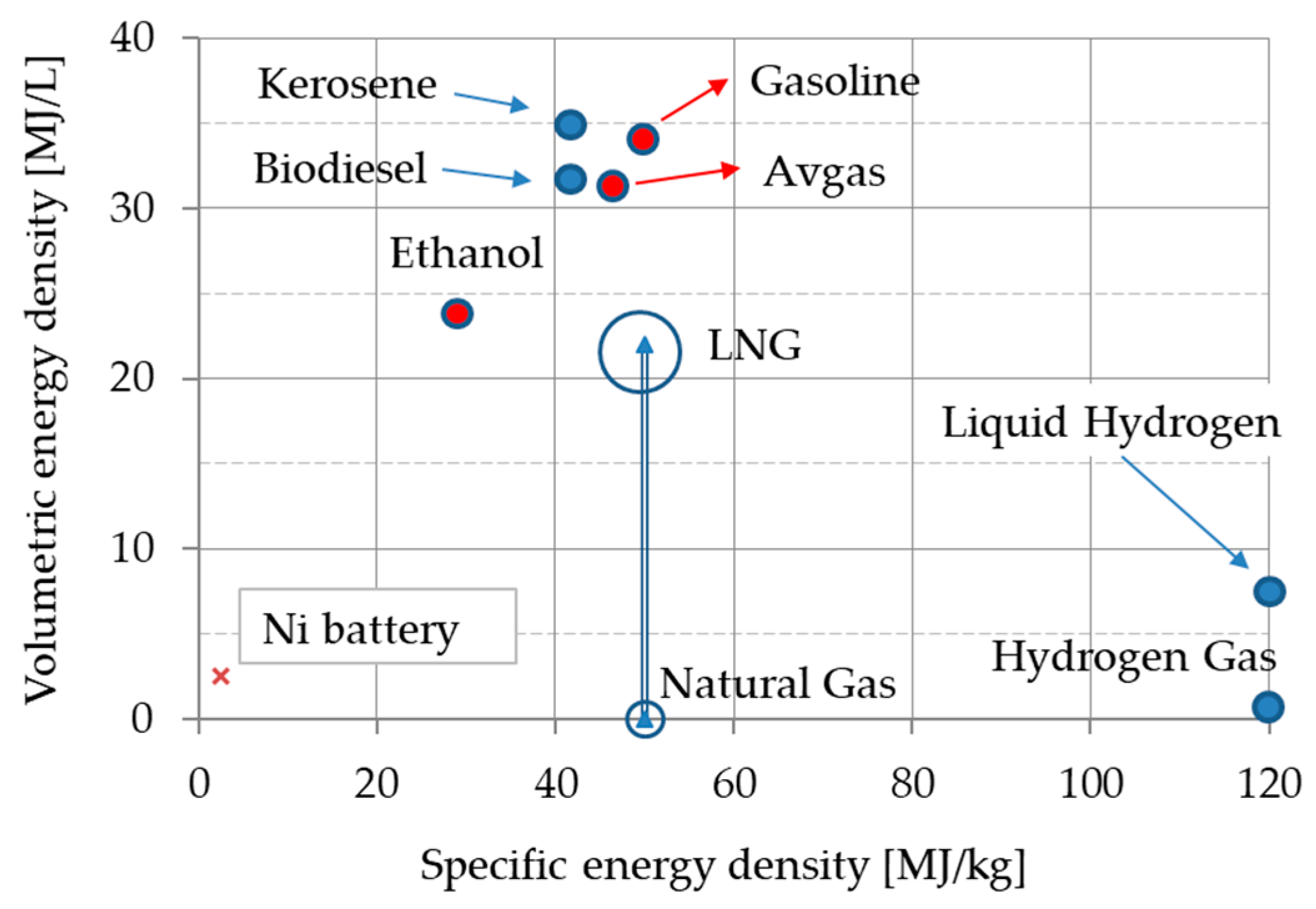
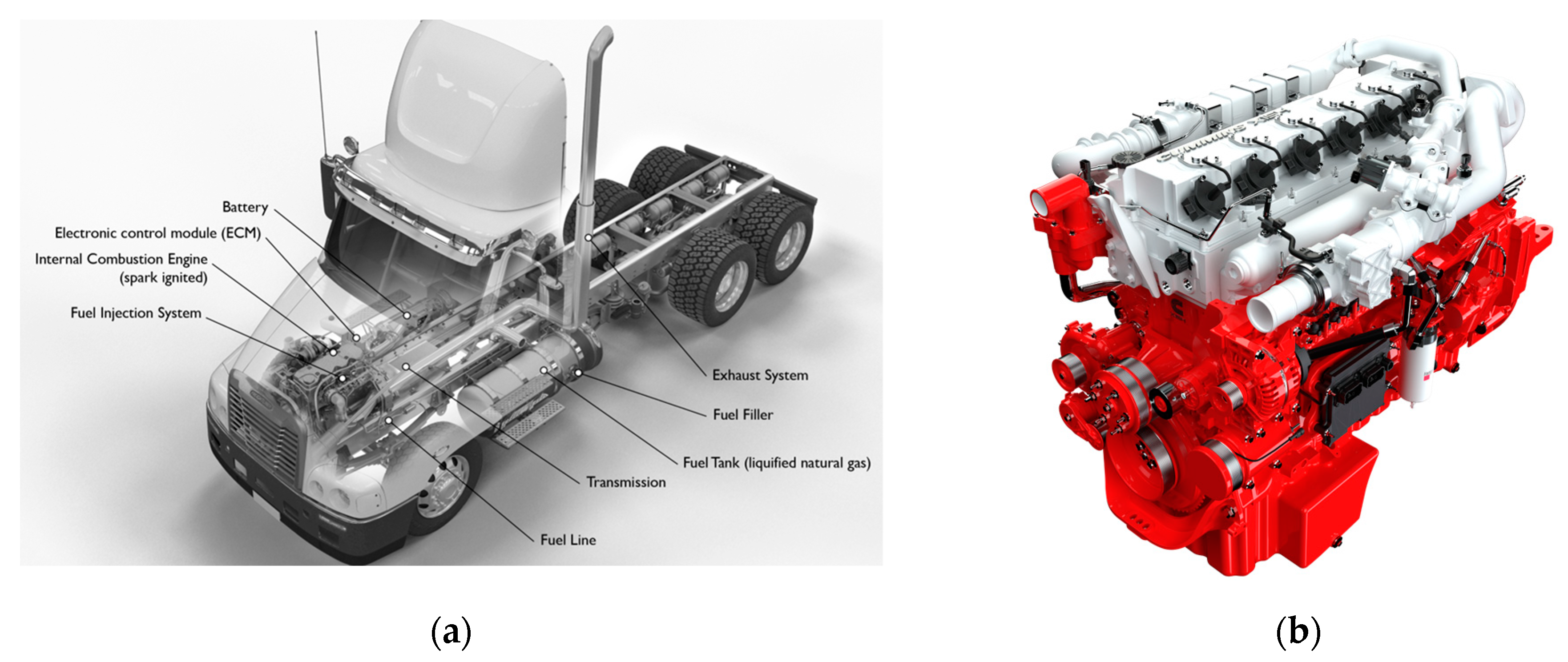
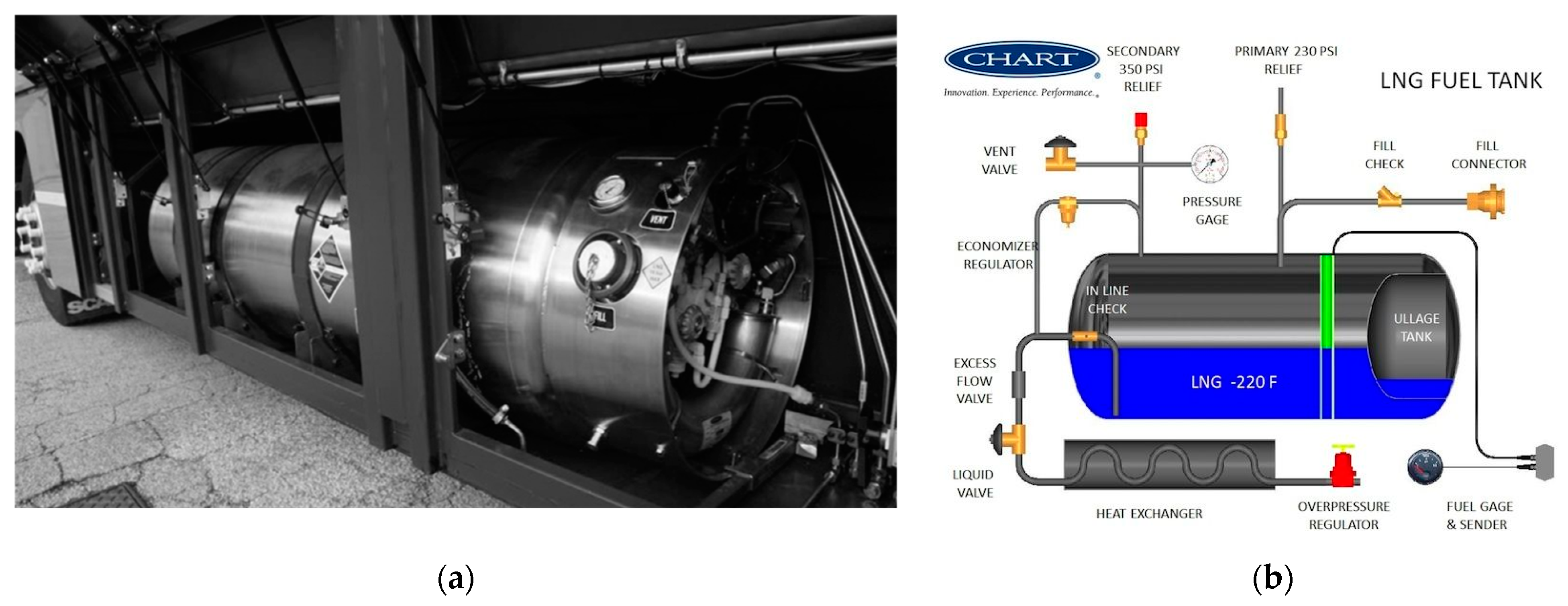
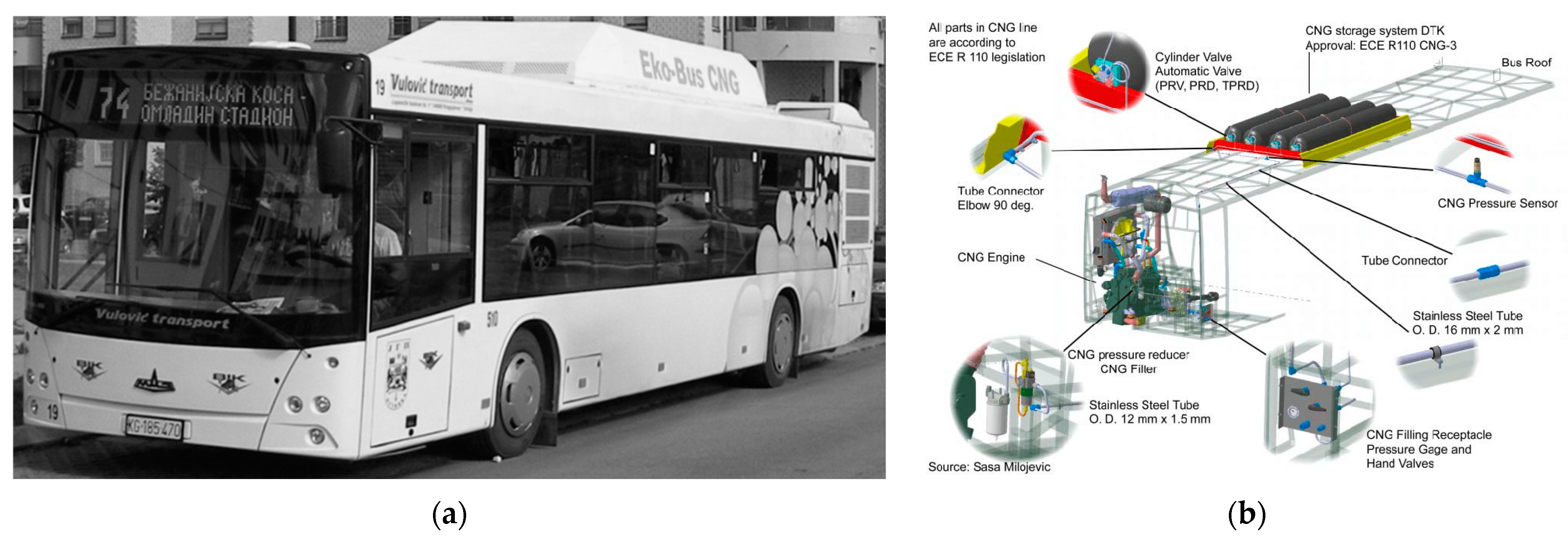
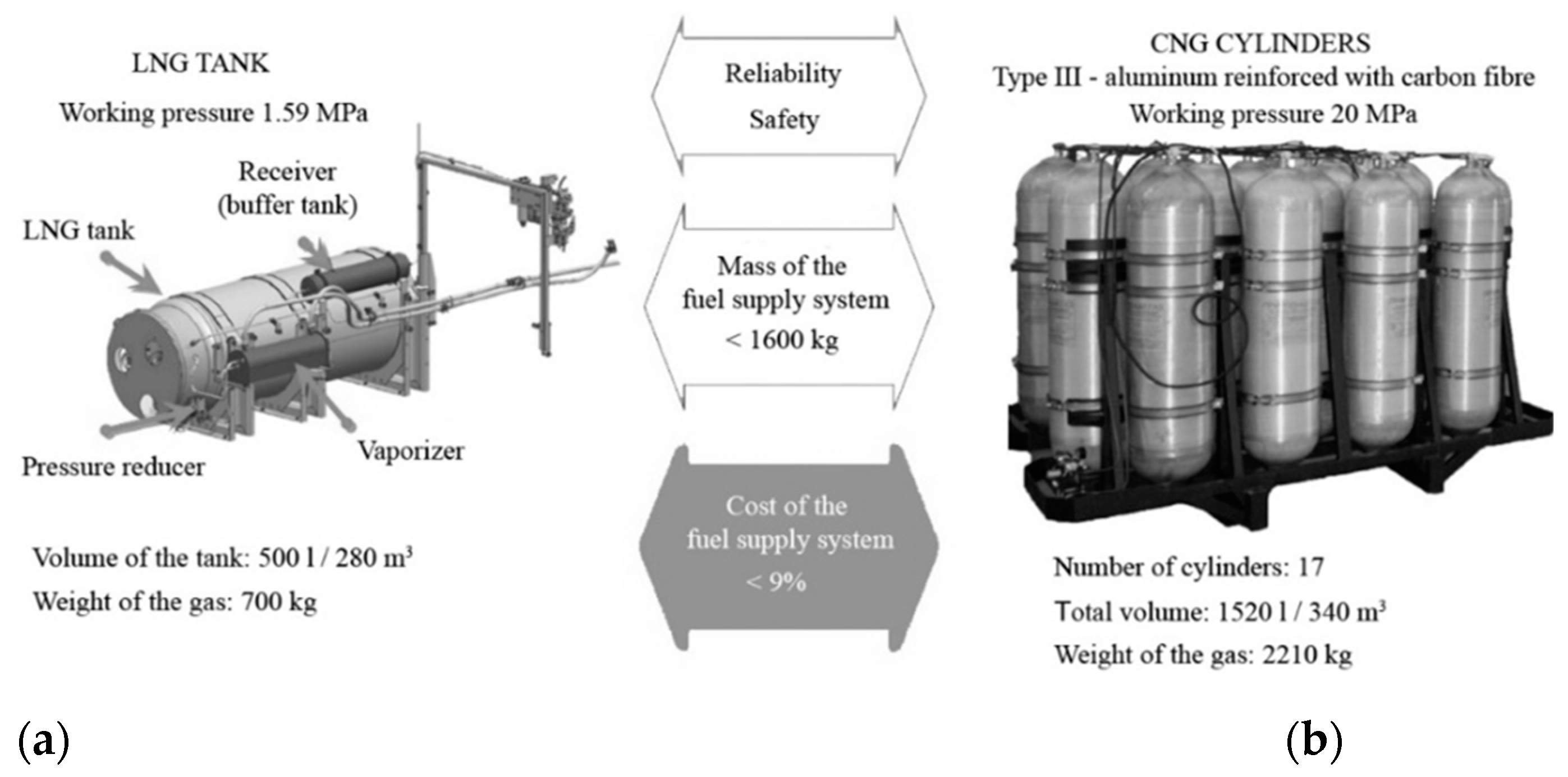


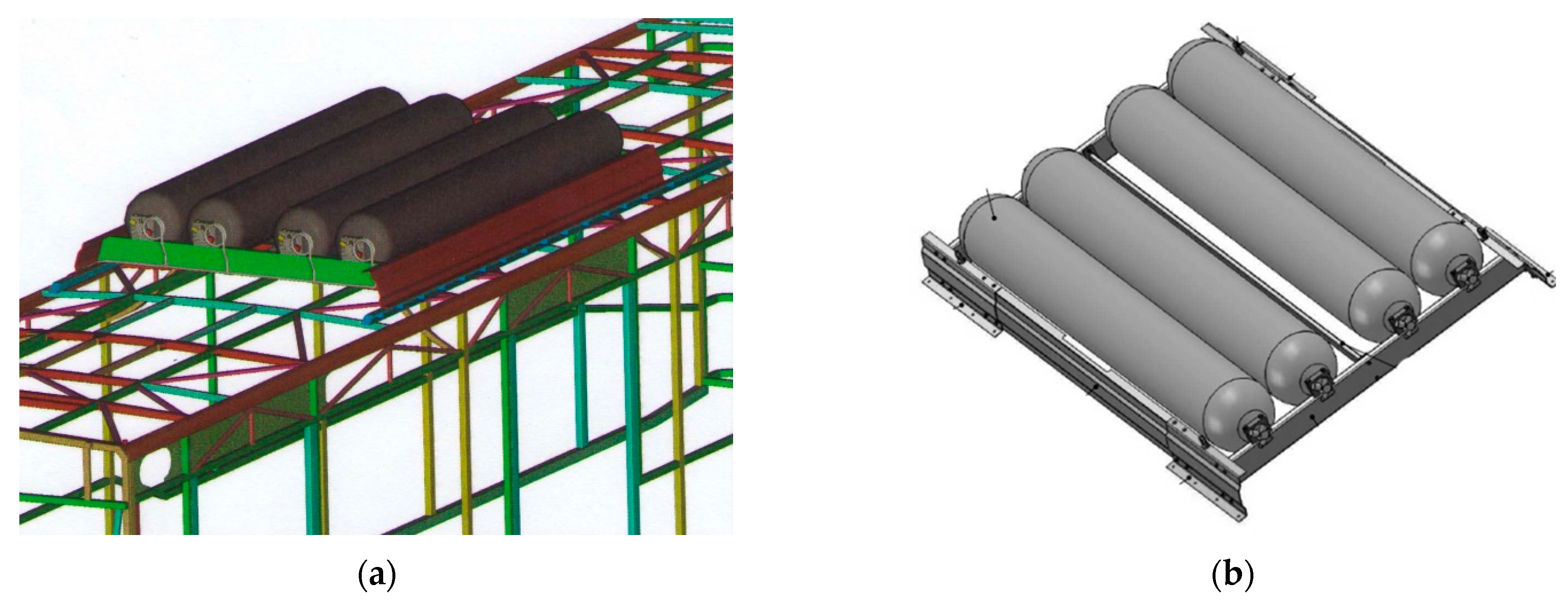
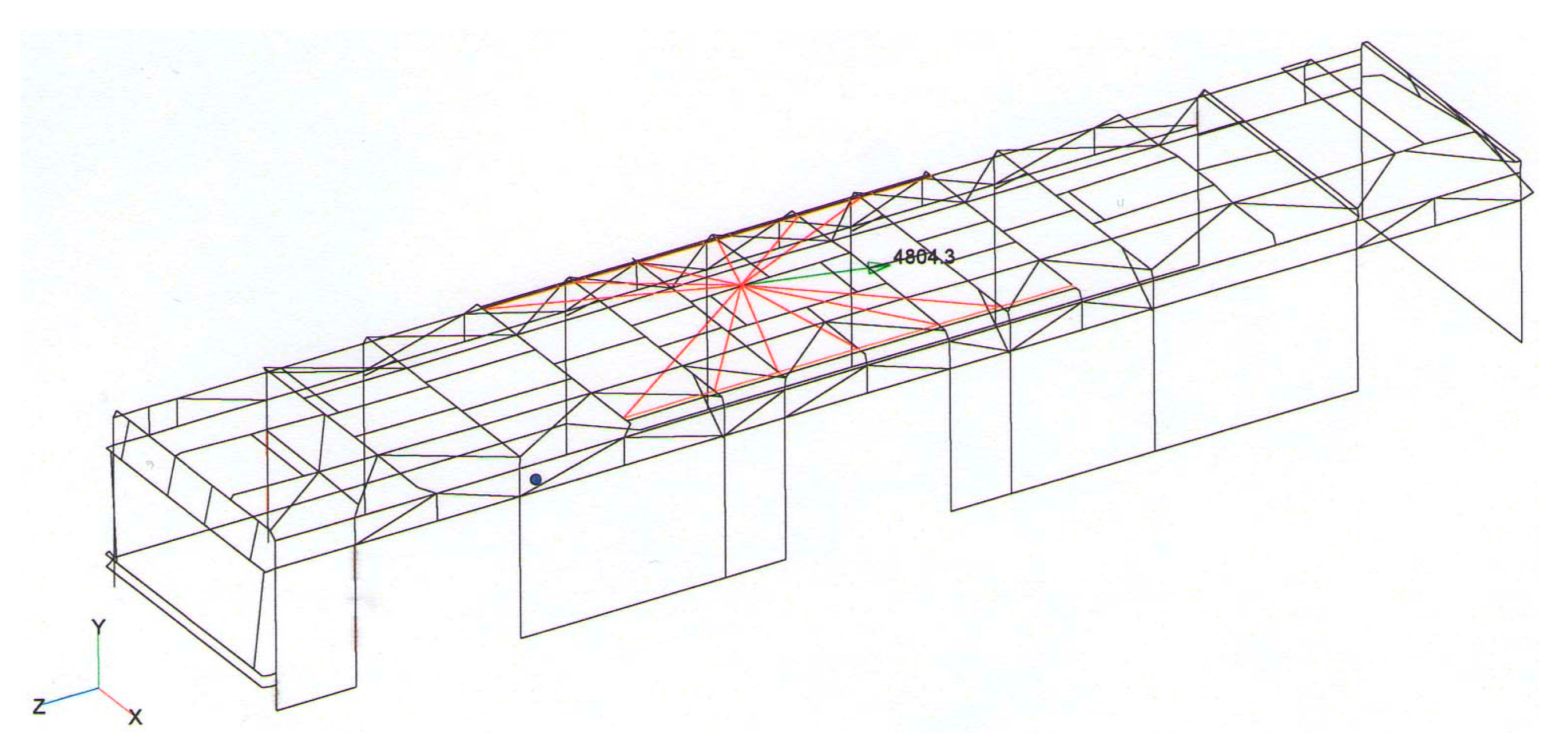
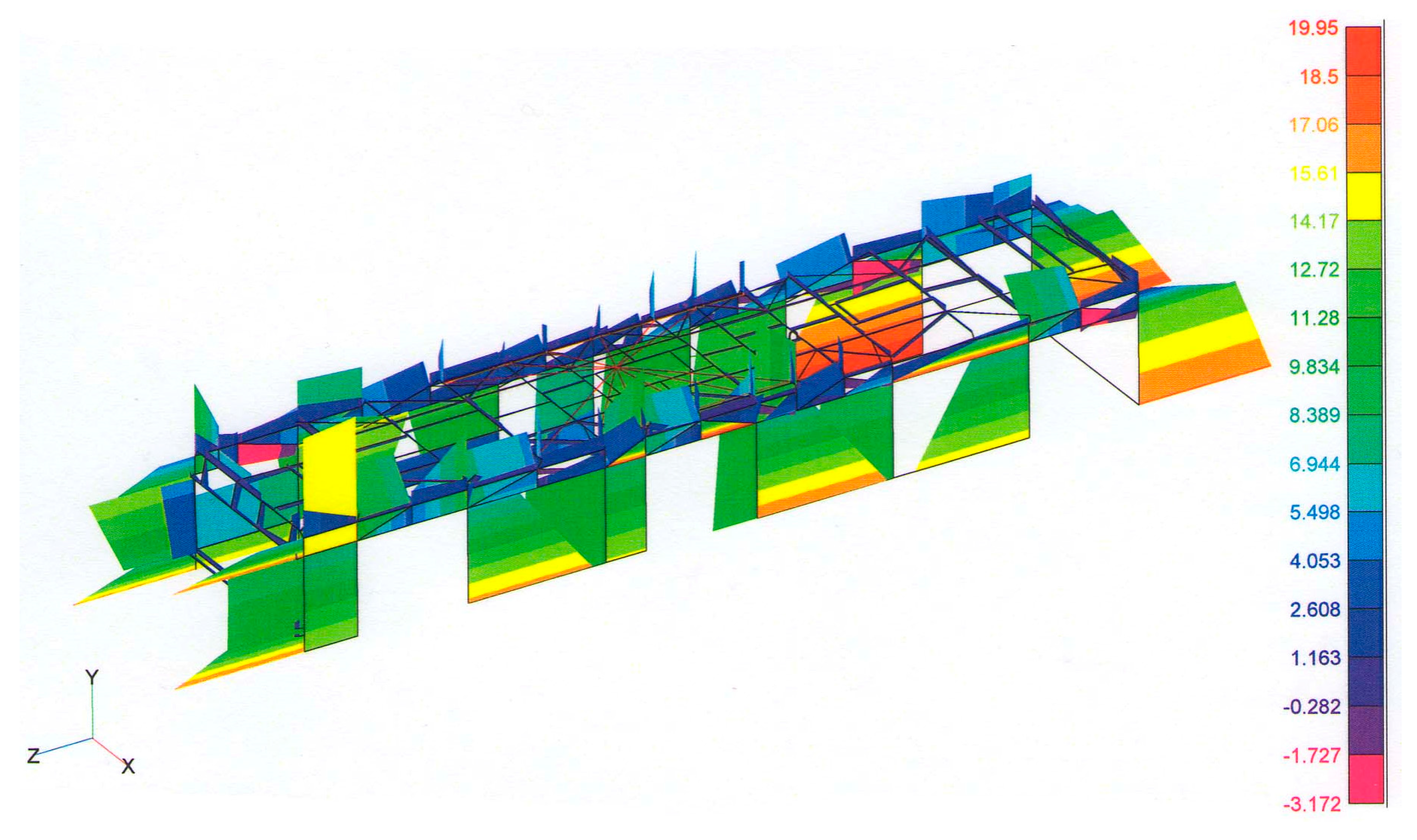

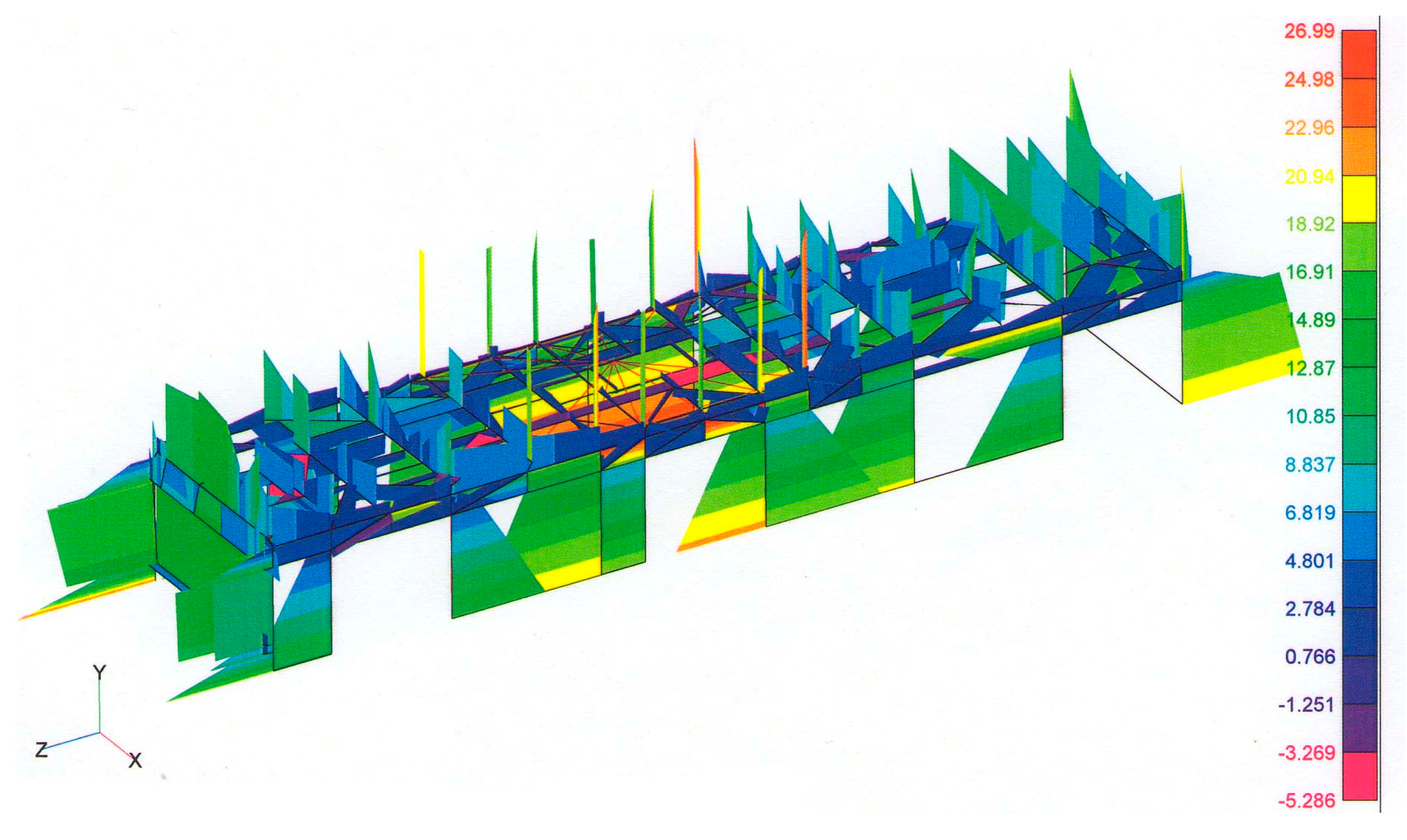
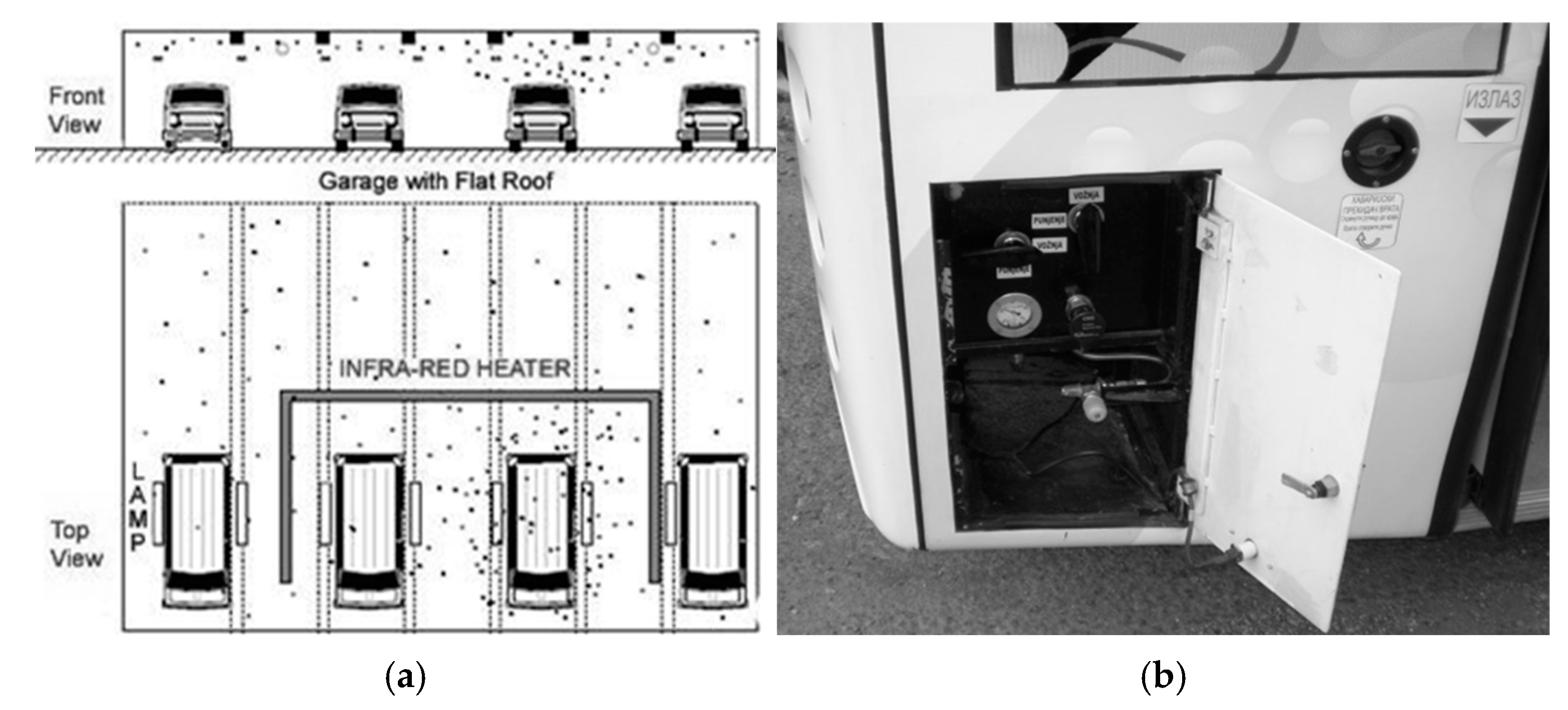
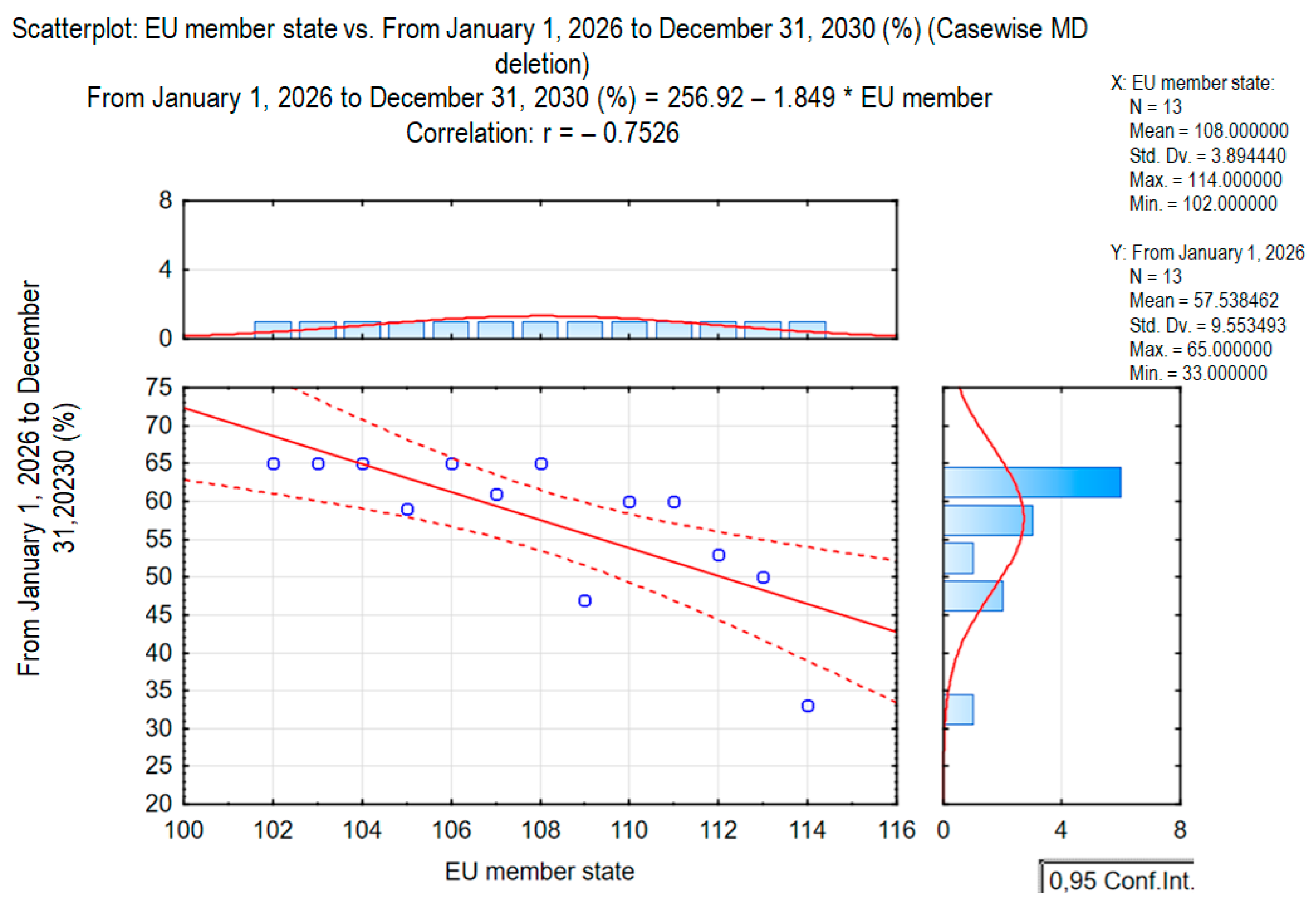
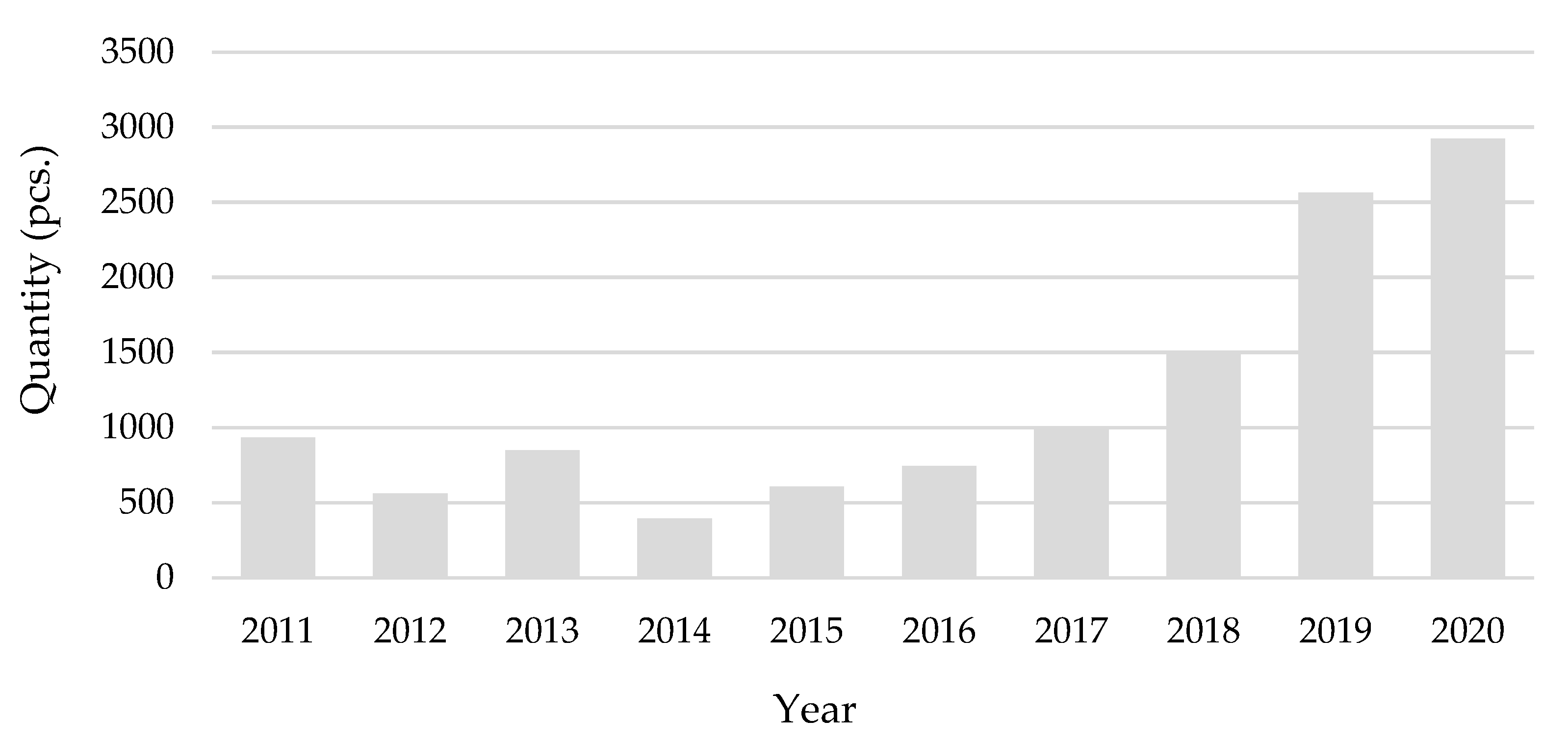
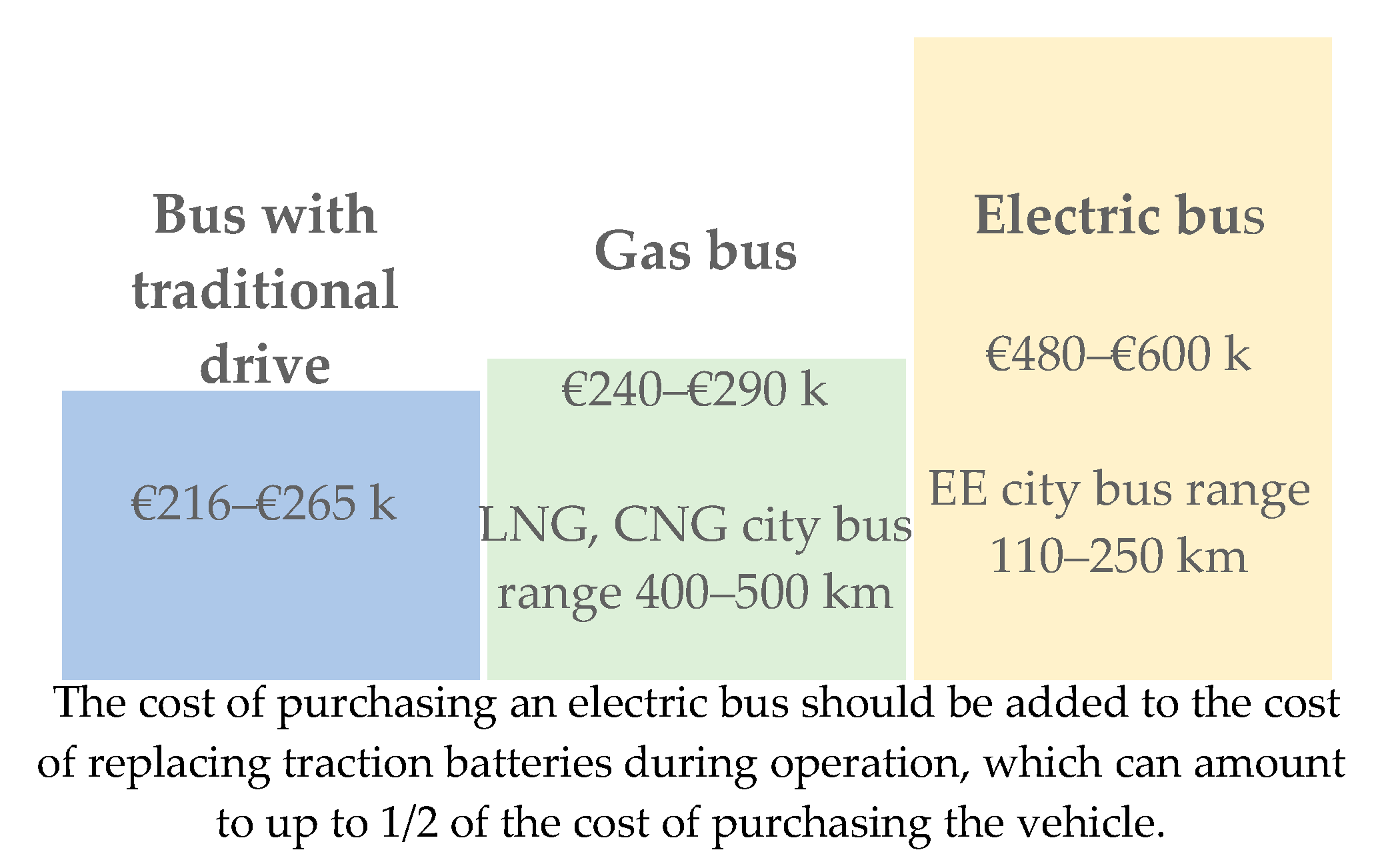
| Categories of Motor Vehicles | ||||
|---|---|---|---|---|
| M2 | M3 | N2 | N3 | |
| Total number of vehicles | 862 | 7959 | 24,511 | 55,415 |
| LNG—liquefied natural gas | - | - | - | 127 |
| CNG—compressed natural gas | 1 | 257 | 12 | 74 |
| Categories of Motor Vehicles | M1 and N1 | M2 and N2 | M3 and N3 |
|---|---|---|---|
| The acceleration of a vehicle: | |||
| —in the driving direction | 20∙g | 20∙g | 6.6∙g |
| —perpendicular to the driving direction | 8∙g | 5∙g | 5∙g |
| Categories of Motor Vehicles Using Natural Gas | Intervals of Regular Inspections (Maximum) |
|---|---|
| Passenger cars falling into the M1 category (not including taxi vehicles and ambulances) Heavy-duty vehicles: N1 category | Every two years (four years after the date of first registration) |
| Buses in the M2 and M3 categories Taxi vehicles and ambulances Heavy-duty vehicles: N2 and N3 categories | Every year (one year after the date of first registration) |
| Buses (Category M3) | ||
|---|---|---|
| EU Member State | From 2 August 2021 to 31 December 2025 (%) | From 1 January 2026 to 31 December 2030 (%) |
| Luxembourg | 45 | 65 |
| Sweden | 45 | 65 |
| Denmark | 45 | 65 |
| Finland | 41 | 59 |
| Germany | 45 | 65 |
| France | 43 | 61 |
| Spain | 45 | 65 |
| Greece | 33 | 47 |
| Czech Republic | 41 | 60 |
| Lithuania | 42 | 60 |
| Hungary | 37 | 53 |
| Latvia | 35 | 50 |
| Romania | 24 | 33 |
| Type | Price (EUR) | Level of Participation in Purchase Costs (%) | Fuel Price (EUR/100 km) | Potential Course During Operation (km) | |
|---|---|---|---|---|---|
| State | Municipality | ||||
| Diesel solo bus | 240,530 | 0 | 100 | 245.3 | 800,000 |
| Gas solo bus | 264,580 | 0 | 100 | 251.7 | 800,000 |
| EV solo bus | 505,110 | 80 | 20 | 122.9 | 600,000 |
| H2 solo bus | 721,640 | 90 | 10 | 423.0 | 800,000 |
Disclaimer/Publisher’s Note: The statements, opinions and data contained in all publications are solely those of the individual author(s) and contributor(s) and not of MDPI and/or the editor(s). MDPI and/or the editor(s) disclaim responsibility for any injury to people or property resulting from any ideas, methods, instructions or products referred to in the content. |
© 2025 by the authors. Licensee MDPI, Basel, Switzerland. This article is an open access article distributed under the terms and conditions of the Creative Commons Attribution (CC BY) license (https://creativecommons.org/licenses/by/4.0/).
Share and Cite
Milojević, S.; Stopka, O.; Orynycz, O.; Tucki, K.; Šarkan, B.; Savić, S. Exploitation and Maintenance of Biomethane-Powered Truck and Bus Fleets to Assure Safety and Mitigation of Greenhouse Gas Emissions. Energies 2025, 18, 2218. https://doi.org/10.3390/en18092218
Milojević S, Stopka O, Orynycz O, Tucki K, Šarkan B, Savić S. Exploitation and Maintenance of Biomethane-Powered Truck and Bus Fleets to Assure Safety and Mitigation of Greenhouse Gas Emissions. Energies. 2025; 18(9):2218. https://doi.org/10.3390/en18092218
Chicago/Turabian StyleMilojević, Saša, Ondrej Stopka, Olga Orynycz, Karol Tucki, Branislav Šarkan, and Slobodan Savić. 2025. "Exploitation and Maintenance of Biomethane-Powered Truck and Bus Fleets to Assure Safety and Mitigation of Greenhouse Gas Emissions" Energies 18, no. 9: 2218. https://doi.org/10.3390/en18092218
APA StyleMilojević, S., Stopka, O., Orynycz, O., Tucki, K., Šarkan, B., & Savić, S. (2025). Exploitation and Maintenance of Biomethane-Powered Truck and Bus Fleets to Assure Safety and Mitigation of Greenhouse Gas Emissions. Energies, 18(9), 2218. https://doi.org/10.3390/en18092218








